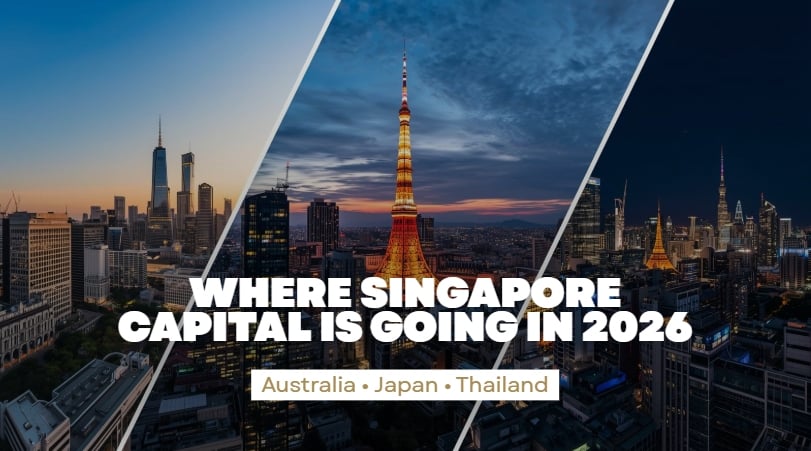|
City |
Vacancy Rate |
Average Yield |
Population Growth |
|---|---|---|---|
|
Melbourne |
0.7% |
4.2-5% |
Highest in Australia |
|
Perth |
0.4% |
5-6% |
Fastest household income growth |
|
Brisbane |
0.9% |
4.5-5% |
Olympics 2032 uplift |
|
Sydney |
1.2% |
3.5-4% |
Highest absolute rents |
Where Singapore Capital Is Going in 2026: Australia, Japan & Thailand

A few days ago, Melissa WhatsApped me late at night. No emojis, no greetings, just one sentence:

She had just gone through my Sentosa article, “The Fall and Possible Future of Sentosa Properties”, and it shook her. She owned a high-end condo, purchased during an era when Singapore property was unstoppable, where prices consistently rose, liquidity was virtually guaranteed, and demand was never in question.
But 2023–2025 changed everything.
The World Has Shifted, and Singapore's Capital Is Shifting With It
2026 is the year Singaporeans start asking:
“Which country is safest, easiest, most profitable, and still early?”
Because whether we like it or not, the global environment has changed:
- Singapore’s ABSD for foreigners remains at 60%, unchanged.
- Foreign demand has collapsed from 25% to under 5% in some segments.
- Core Central Region prices remain high, but volume is thinning.
- Outbound Singaporean purchases rose 34% year-on-year across top destinations.
- Asian retirement migration is rising faster than at any time in the last decade.
- School-driven property purchases continue to grow.
- Wealth diversification is no longer optional — it’s strategic.
Singapore is still the safe core of your portfolio. But the growth, the yield, the affordability, the upside — that’s happening abroad.
And if you’ve read my previous piece, “The Fall and Possible Future of Sentosa Properties,” you know the direction is clear:
When local liquidity slows and foreign restrictions tighten, Capital searches for friendlier, younger, more open markets.
2026’s top three? Australia. Japan. Thailand.
Let’s explore why.
AUSTRALIA — The Most Natural Extension of Singapore Wealth
Let me start with the country I personally fly to the most and advise on the most.
Why? Because Australia is the most logical, low-risk, high-consistency destination for Singapore investors today.

Why Singapore capital loves Australia:
- Favorable foreign ownership rules
- No ABSD
- Strong, transparent legal system
- World-class education
- Migration-driven rental demand
- High occupancy rates
- Low vacancy (<1% in many cities)
- Predictable long-term appreciation
- Stable political environment
- English-speaking
- High liquidity
- Easy financing (for some nationalities)
But the real magic?
Australia is entering a supply crisis while population growth is accelerating.
This creates a very rare window — a “compressed demand” cycle so strong that even older properties are seeing multiple offers.
2025–2026 Rental Data Snapshot (Australia)
Singaporeans are buying primarily in: Melbourne → Perth → Brisbane → Sydney
Why Melbourne leads the list
1. Education capital of Australia
220,000 international students. Rental demand = guaranteed.
2. Lowest entry prices among major cities
New builds from A$450k–A$650k. That’s less than a 2-room condo in Singapore.
3. Strong rental growth
Many of my clients saw 15–25% rental increase post-2023.
4. Massive migration inflow
Melbourne is projected to surpass Sydney in population by 2035.
5. Best value for Singaporeans
You get space, yield, and future growth at a price that still makes sense.
Clients tell me:
“Josh… buying in Melbourne feels like buying in Singapore 20 years ago.”
And honestly? They’re right.
|
I have a client from Tanglin, let's call him "Mr. L". He sold his CCR condo after 8 years, made a profit, but realised re-entering meant paying ABSD again.
His exact words: “Why didn’t I do this earlier?” |
This is the story I see again and again.
I always laugh when clients tell me: “No la Josh, buy for investment only. Not migrating.”
Then 6 months later: “So ah, how to apply PR?”
Most Singaporeans want options. Australia gives them that.
You own property. Your kids study there. You spend 3–4 years. Doors start opening.
JAPAN — The Market With the Strongest Momentum Right Now
Japan is the quiet tiger.
It doesn’t shout. It doesn’t hype. It doesn’t “trendy-marketing” its property sector.
But the fundamentals? Insanely attractive.

Why Singapore capital loves Japan:
- Low entry prices
- Foreigners can own freehold property
- Strong yield cities (Fukuoka, Sapporo, Osaka)
- Tokyo is still undervalued on a global scale
- Tourism recovery is explosive
- Yen is historically weak → huge currency advantage
- Global funds are buying aggressively
- Government welcomes foreign investors
- Rental demand is strong in urban areas
- Safe, predictable, stable
- Extremely low interest rates
Japan is the “smart money” market of 2026.
Tokyo is now the most populous metropolitan area on earth, with 37 million people. Rental demand is hardcore because:
- People prefer to rent, not buy
- Interest rates are near 0%
- Young adults move into Tokyo for work
- Tourism is back at record levels
The institutional investors are already there. Singapore family offices are quietly buying blocks. REITs have been positioning since 2023.
When you sell in Tokyo, you’re not waiting for one rich buyer. You’re entering a deep, liquid marketplace.
And the biggest catalyst?
The Yen is still weak.
This alone creates massive buying power:
- In 2012: S$1 = ¥63
- In 2025: S$1 = ¥113–119
Meaning:
✔ You’re buying at a 40–45% currency discount
✔ Your capital goes almost twice as far
✔ When the Yen rebounds in the next cycle (which it will), your property gets a double-boost: yield + forex gain.
Even if the yen appreciates 10–20% in the next few years, Singapore investors who buy today will enjoy: capital gain,forex gain, rental gain.
A triple-win you rarely see in real estate.
Top Japanese Cities Singaporeans Are Buying in 2026
|
City |
Why It's Hot |
Expected Yield |
|---|---|---|
|
Tokyo |
Liquidity, safety, long-term appreciation |
4-5.5% |
|
Osaka |
Expo 2025, tourism boom |
4-6% |
|
Fukuoka |
Young population, tech hub |
5-6% |
|
Sapporo |
Short-term rental potential |
6-8% |
|
Kyoto |
Tourist-driven capital growth |
Variable |
THAILAND — The Rise of Lifestyle + Investment Hybrid Markets
This one is the dark horse of Southeast Asia. The market most Singapore investors overlook.
Why Singapore capital loves Thailand in 2026:
- New foreign-friendly property regulations
- Explosive tourism recovery
- High rental yields (especially short stay)
- Low entry prices
- Favored by digital nomads
- Infrastructure boom (LRT expansions, high-speed rail)
- Bangkok’s new regeneration zones attracting foreign capital
- Phuket’s villa market on fire
- Chiang Mai gaining popularity for retirement
Thailand is no longer a “vacation home” market. It is becoming one of Asia’s fastest-growing lifestyle investment hubs.

Bangkok — The Urban Investment Case
Bangkok’s regeneration projects (Dusit, Ratchada, Rama 9, Thonburi) are transforming the city.
New malls, hospitals, international schools, and rail lines — all pumping value into previously overlooked districts.
Foreigners are buying mostly in:
- Rama 9
- Thonglor
- Sukhumvit
- Asoke
- Ratchada
- Bangna
Yields? 5–7% if you pick well.
Phuket — The Lifestyle + Rental Hybrid
Phuket is no longer just tourism-driven.
It is now:
- A digital nomad hub
- A medical tourism hub
- A luxury wellness hub
- A premium beachfront investment market
Entry from US$220k–$500k for well-managed developments. Many offering 8–12% gross rental during peak seasons.
Clients love this angle.
Own a villa in Phuket → rent it out → stay for holidays → get 8–10% returns.
You can’t do that in Singapore. You can’t do that in Japan. You can’t legally do that in Australia. But in Thailand? It’s welcomed.
Chiang Mai — The Retirement Surprise
More Singaporeans are now retiring in Chiang Mai than ever.
Why?
- Affordability
- Cool climate
- Slower pace
- Lower cost of living
- Large expat community
- Long-term stay visas via LTR & Smart Visa programs
If you want lifestyle + peace + low cost + high yield, this is the “under-the-radar gem.”
So, Where Should YOU Go Next?
If you want:
- stability, education access, long-term appreciation → go Australia
Especially Melbourne, Brisbane, and Perth.
- yield, forex upside, Japan exposure → go Japan
Tokyo for safety, Osaka/Fukuoka for yield.
- high returns, lifestyle, tourism → go Thailand
Bangkok for urban growth, Phuket for villa income.

Most Singaporeans Are Too Late Locally… But Still Early Globally
Singapore’s growth curve has matured. Returns are tightening. Upside is slower.
But internationally?
You’re still EARLY. This is why your timing matters.
I’ve worked with many investors for almost 2 decades.
The pattern is the same:
Once you hit a certain level of success in Singapore, your next step is international.
When locals feel “stuck,” they diversify. When foreigners feel “priced out,” they relocate capital.
This is exactly what’s happening now.
If you're serious about investing globally, let’s build your global portfolio.
Message me now!